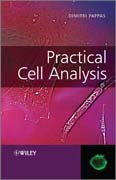
As analytical chemistry and biology move closer together, biologists are performing increasingly sophisticated analytical techniques on cells. Chemists arealso turning to cells as a relevant and important sample to study newly developed methods. Practical Cell Analysis provides techniques, hints, and time-saving tips explaining what may be “common knowledge” to one field but are often hidden or unknown to another. INDICE: Chapter 1: Getting Starting (and Getting the Cells) 1.1 Introduction 1.2 The Driving Need 1.3 Primary and Cultured Cells 1.4 Choosing a CulturedCell 1.5 Choosing Primary Cells 1.6 Easily Obtainable Primary Cells 1.7 Primary Cells from Tissues 1.8 Purifying Primary Cells 1.9 How Long do Primary Cells Remain Primary? 1.10 Obtaining Primary Cells from a Commercial Source 1.11 Bacteria and Yeast 1.12 Practical Aspects of Cell Culture 1.13 Safety Aspects of Primary and Transformed Cell Lines 1.14 Transfection of Primary and Transformed Cell Lines 1.15 Conclusion References Chapter 2: The Cell Culture Laboratory (Tools of the Trade) 2.1 Introduction 2.2 Issues Concerning a Cell Laboratory 2.3 Setting up a Cell Culture Laboratory 2.4 Cell Line Storage 2.5 PersonalProtective Equipment 2.6 Cell and Sample Handling 2.7 Common Analytical Instrumentation for Cell Culture 2.8 Considerations when Setting up a Cell Culture Laboratory 2.9 Establishing and Regulating A Culture Facility 2.10 Conclusion References Chapter 3. Maintaining Cultures 3.1 Introduction 3.2 Medium 3.3 TheUse of Medium in Analysis, and Alternatives 3.4 Culturing Cells Protocol 3.1:Sub-Culture of Adherent Cells 3.5 Growing Cells in Three Dimensions 3.6 Sterility and Contamination of Culture 3.7 Storage of Cell Samples and Cell Lines Protocol 3.2: Cryopreservation of Mammalian Cells Protocol 3.3: Retrieval of Cells from Liquid Nitrogen Storage 3.8 Conclusion References Chapter 4. Microscopy of Cells 4.1 Introduction 4.2 Microscope Types 4.3 Culturing Cells for Microscopy 4.4 Signals, Background, and Artifacts in Optical Microscopy 4.5 Staining Cells for Fluorescence Microscopy 4.6 Multiple Labels 4.7 Viability and Two-Photon Microscopy 4.8 Spatial Resolution in Optical Microscopy 4.9 Image Saturation and Intensity 4.10 Atomic Force and Environmental Scanning Electron Microscopy 4.11 Conclusion References Chapter 5: Separating Cells 5.1 Introduction 5.2 The Cell Sample 5.3 Label-Free (Intrinsic) Separations 5.4 Immunomagnetic Sorting 5.5 Cell Affinity Chromatography 5.6 Affinity Chemistry Considerations in CAC and MACS Separations Protocol 5.1: Screening of Antibody Clones 5.7 Elution in Cell Affinity Chromatography 5.8 Nonspecific Binding in Cell Separations 5.9 Separation of Rare Cells 5.10 Fluorescence Activate Cell Sorting 5.11 Sorting Parameters 5.12 Other Separation Techniques and Considerations 5.13 Conclusion References Chapter 6. Flow Cytometry: Cell Analysis in the Fast Lane 6.1 Introduction 6.2 The Cell Sample 6.3 Flow Cytometer Function 6.4 Obtaining or Finding a Flow Cytometer 6.5 Using Flow Cytometers 6.6 Setting up a FlowCytometer for Multi-Color Staining 6.7 Analyzing Flow Cytometry Data 6.8 Example Flow Cytometry Assays 6.9 No-Flow Cytometry 6.10 Conclusion References Chapter 7: Analyzing Cells with Microfluidic Devices 7.1 Introduction 7.2 Advantages of Microfluidics 7.3 Considerations of Microfluidics and Cells 7.4 Obtaining Microfluidic Cell Devices 7.5 Microfluidic Flow Cytometry 7.6 Cell Separations 7.7 Analysis of Cell Products 7.8 Cell Culture Protocol 7.1: Low-shear Cell Culture Chip 7.9 Conclusion References Chapter 8: Statistical Considerations8.1 Introduction 8.2 Types of Error 8.3 Figures of Merit in Statistical Analysis of Cells 8.4 Limits of Detection and Quantitation (of Cell) 8.5 Methods toImprove Cell Statistics 8.6 Comparing Analytical Values 8.7 Rejecting Data: Proceed With Caution 8.8 Conclusion References Chapter 9 Protocols, Probes, andStandards 9.1 Introduction 9.2 Cell Transfection and Immortalization (Chapter1) Protocol 9.1: Transfecting Cells with Polyamine Reagents Protocol 9.2: Stable Transfection using Polyamine Delivery Protocol 9.3: Transfection Using Electroporation Optimizing Electroporation Parameters Protocol 9.4: Cell Immortalization using hTERT Transfection 9.3 Calculating Relative Centrifugal Force (RCF) and Centrifuge Rotor Speed (Chapter 2) 9.4 Fluorescence Methods (Chapter 4& 6) Protocol 9.4: Apoptosis Detection Using Fluorophore-Conjugated Annexin-Vand a Viability Dye Protocol 9.5: Apoptosis Detection Using Fluorogenic Caspase Probes 9.5 Surface Modifications for Cell Analysis (Chapter 5 & 7) Protocol9.6: Covalent Linkage of Proteins (non-Antibody) to Glass by Microcontact Imprinting Protocol 9.7: Covalent Linkage of Antibodies to Glass Protocol 9.8: Noncovalent Attachment of Antibodies to Glass #1 Protocol 9.9: Noncovalent Attachment of Antibodies to Glass or PDMS #2 Protocol 9.10: Blocking Endogenous Biotin 9.6 Flow Cytometry and Cell Separations (Chapter 5 & 6) Protocol 9.11: Cell Cycle Measurements by Flow Cytometry Protocol 9.12: Antigen Density Measurements in Flow Cytometry Protocol 9.13: Antigen Density Measurements using Fluorescence Correlation Spectroscopy. Protocol 9.14: Cell Proliferation using Anti-CD71 staining (Chapter 4 & 6). 9.7 Fluorescent Labels and Fluorogenic Probes (Chapter 4, 6 & 7) References.
- ISBN: 978-0-470-74155-9
- Editorial: John Wiley & Sons
- Encuadernacion: Cartoné
- Páginas: 294
- Fecha Publicación: 01/02/2010
- Nº Volúmenes: 1
- Idioma: Inglés
